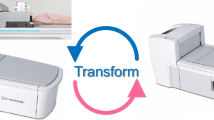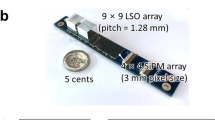Abstract
Objectives
Technical performance evaluation of a human brain PET/MRI system.
Methods
The magnetic field compatible positron emission tomography (PET) insert is based on avalanche photodiode (APD) arrays coupled with lutetium oxyorthosilicate (LSO) crystals and slip-fits into a slightly modified clinical 3-T MRI system. The mutual interference between the two imaging techniques was minimised by the careful design of the hardware to maintain the quality of the B 0 and B 1 field homogeneity.
Results
The signal-to-noise ratio (SNR) and the homogeneity of the MR images were minimally influenced by the presence of the PET. Measurements according to the Function Biomedical Informatics Research Network (FBIRN) protocol proved the combined system’s ability to perform functional MRI (fMRI). The performance of the PET insert was evaluated according to the National Electrical Manufacturers Association (NEMA) standard. The noise equivalent count rate (NEC) peaked at 30.7 × 103 counts/s at 7.3 kBq/mL. The point source sensitivity was greater than 7 %. The spatial resolution in the centre field of view was less than 3 mm. Patient data sets clearly revealed a noticeably good PET and MR image quality.
Conclusion
PET and MRI phantom tests and first patient data exhibit the device’s potential for simultaneous multiparametric imaging.
Key Points
• Combination of PET and MRI is a new emerging imaging technology.
• Evaluated brain PET/MRI enables uncompromised imaging performance.
• PET/MRI aims to provide multiparametric imaging allowing acquisition of morphology and metabolism.






Similar content being viewed by others
Abbreviations
- AC:
-
attenuation correction
- AC_T1_FLASH3D:
-
T1w flash sequence for attenuation correction
- APD:
-
avalanche photodiode
- B 0 :
-
main magnetic field
- B 1 :
-
radiofrequency field
- BOLD:
-
blood oxygen level-dependent
- CFD:
-
constant fraction discriminator
- CSI:
-
chemical shift imaging sequence
- CP:
-
circular polarised
- EPI:
-
echo planar imaging
- EPI_BOLD:
-
EPI BOLD sequence
- ΔTE:
-
difference between echo times
- FBIRN:
-
Function Biomedical Informatics Research Network
- FLASH:
-
fast low angle shot
- FWHM:
-
full width at half maximum
- FWTM:
-
full width at tenth maximum
- G-APD:
-
Geiger mode avalanche photodiode
- γ:
-
gyromagnetic ratio
- GE_MAP:
-
gradient echo map
- LSO:
-
lutetium oxyorthosilicate
- MRS:
-
magnetic resonance spectroscopy
- NEMA:
-
National Electrical Manufacturers Association
- NEC:
-
noise equivalent count rate
- NSE:
-
normal spin echo
- OP-OSEM3D:
-
ordinary Poisson ordered subset expectation maximisation
- P(TE10):
-
phase map with echo time of 10 ms
- P(TE20):
-
phase map with echo time of 20 ms
- r_dc:
-
radius of decorrelation
- RF_FIELD:
-
B 1 mapping service sequence
- RF_NOISE:
-
manufacturer service sequence
- rms:
-
root mean square
- SE:
-
spin echo sequence
- σ :
-
noise signal
- s max :
-
maximal signal intensity
- s min :
-
minimal signal intensity
- SFNR:
-
signal to fluctuation noise ratio
- SNR:
-
signal to noise ratio
- STE:
-
stimulated echo
- SVS_SE:
-
single voxel press spectroscopy sequence
- T1_FL2d:
-
T1w flash sequence
- T2_TSE:
-
T2w turbo spin echo sequence
- TOF:
-
time of flight
- TX/RX:
-
transmit/receive
- UTE:
-
ultra short echo time sequence
References
Schlemmer HP, Pichler BJ, Schmand M et al (2008) Simultaneous MR/PET imaging of the human brain: feasibility study. Radiology 248:1028–1035
Pichler BJ, Kolb A, Nagele T, Schlemmer HP (2010) PET/MRI: paving the way for the next generation of clinical multimodality imaging applications. J Nucl Med 51:333–336
Marsden PK, Strul D, Keevil SF, Williams SC, Cash D (2002) Simultaneous PET and NMR. Br J Radiol 75:S53–59
Judenhofer MS, Wehrl HF, Newport DF et al (2008) Simultaneous PET-MRI: a new approach for functional and morphological imaging. Nat Med 14:459–465
Catana C, Procissi D, Wu Y et al (2008) Simultaneous in vivo positron emission tomography and magnetic resonance imaging. Proc Natl Acad Sci U S A 105:3705–3710
Raylman RR, Majewski S, Lemieux SK et al (2006) Simultaneous MRI and PET imaging of a rat brain. Phys Med Biol 51:6371
Catana C, Wu Y, Judenhofer MS, Qi J, Pichler BJ, Cherry SR (2006) Simultaneous acquisition of multislice PET and MR images: initial results with a MR-compatible PET scanner. J Nucl Med 47:1968–1976
Raylman RR, Majewski S, Velan SS, et al (2007) Simultaneous acquisition of magnetic resonance spectroscopy (MRS) data and positron emission tomography (PET) images with a prototype MR-compatible, small animal PET imager. J Magn Res 186:305–310
Heiss WD (2009) The potential of PET/MR for brain imaging. Eur J Nucl Med Mol Imaging 36(Suppl 1):105–112
Antoch G, Bockisch A (2009) Combined PET/MRI: a new dimension in whole-body oncology imaging? Eur J Nucl Med Mol Imaging 36(Suppl 1):113–120
Nekolla SG, Martinez-Moeller A, Saraste A (2009) PET and MRI in cardiac imaging: from validation studies to integrated applications. Eur J Nucl Med Mol Imaging 36(Suppl 1):121–130
Brix G, Lechel U, Glatting G et al (2005) Radiation exposure of patients undergoing whole-body dual-modality 18F-FDG PET/CT examinations. J Nucl Med 46(4):608–613
Buscher K, Judenhofer MS, Kuhlmann MT et al (2010) Isochronous assessment of cardiac metabolism and function in mice using hybrid PET/MRI. J Nucl Med 51:1277–1284
Hofmann M, Steinke F, Scheel V et al (2008) MRI-based attenuation correction for PET/MRI: a novel approach combining pattern recognition and atlas registration. J Nucl Med 49:1875–1883
Martinez-Moller A, Souvatzoglou M, Delso G et al (2009) Tissue classification as a potential approach for attenuation correction in whole-body PET/MRI: evaluation with PET/CT data. J Nucl Med 50:520–526
Catana C, van der Kouwe A, Benner T et al (2010) Toward implementing an MRI-based PET attenuation-correction method for neurologic studies on the MR-PET brain prototype. J Nucl Med 51:1431–1438
Keereman V, Fierens Y, Broux T, De Deene Y, Lonneux M, Vandenberghe S (2010) MRI-based attenuation correction for PET/MRI using ultrashort echo time sequences. J Nucl Med 51:812–818
Watson C, Byars L, Michel C, Rothfuss H (2008) Scatter/trues detection efficiency compensation in scatter correction of PET emission data. IEEE Nucl Sci Symp Conf Rec 5493–5497
Witoszynskyj S, Rauscher A, JrR R, Barth M (2009) Phase unwrapping of MR images using ΦUN – a fast and robust region growing algorithm. Med Image Anal 13:257–268
Jiru F, Klose U (2006) Fast 3D radiofrequency field mapping using echo-planar imaging. Magn Reson Med 56(6):1375–1379
Wehrl HF, Judenhofer MS, Thielscher A, Martirosian P, Schick F, Pichler BJ (2011) Assessment of MR compatibility of a PET insert developed for simultaneous multiparametric PET/MR imaging on an animal system operating at 7 T. Magn Reson Med 65:269–279
Friedman L, Glover GH (2006) Report on a multicenter fMRI quality assurance protocol. J Magn Reson Imaging 23(6):827–839
Kaufman L, Kramer DM, Crooks LE, Ortendahl DA (1989) Measuring signal-to-noise ratios in MR imaging. Radiology 173:265–267
Byars LG, Sibomana M, Burbar Z, et al (2005) Variance reduction on randoms from coincidence histograms for the HRRT. IEEE Nucl Sci Symp Conf Rec 2622–2626
Hong IK, Chung ST, Kim HK, Kim YB, Son YD, Cho ZH (2007) Ultra fast symmetry and SIMD-based projection-backprojection (SSP) algorithm for 3-D PET image reconstruction. IEEE Trans Med Imaging 26:789–803
Zaidi H, Hasegawa B (2003) Determination of the attenuation map in emission tomography. J Nucl Med 44:291–315
Hofmann M, Pichler B, Scholkopf B, Beyer T (2009) Towards quantitative PET/MRI: a review of MR-based attenuation correction techniques. Eur J Nucl Med Mol Imaging 36(Suppl 1):93–104
Kolb A, Lorenz E, Judenhofer MS, Renker D, Lankes K, Pichler BJ (2010) Evaluation of Geiger-mode APDs for PET block detector designs. Phys Med Biol 55(7):1815–1832
de Jong HW, van Velden FH, Kloet RW, Buijs FL, Boellaard R, Lammertsma AA (2007) Performance evaluation of the ECAT HRRT: an LSO-LYSO double layer high resolution, high sensitivity scanner. Phys Med Biol 52:1505–1526
Boss A, Kolb A, Hofmann M et al (2010) Diffusion tensor imaging in a human PET/MR hybrid system. Invest Radiol 45:270–274
Boss A, Bisdas S, Kolb A et al (2010) Hybrid PET/MRI of intracranial masses: initial experiences and comparison to PET/CT. J Nucl Med 51:1198–1205
Acknowledgments
The authors thank Andreas Schmid and Johannes Breuer for their helpful advice on programming the software for the data analysis. We thank the Radiopharmacy of the University Hospital Tübingen for providing the radiotracers as well as Andreas Boss for helpful discussions.
The authors also appreciate the discussions within the Brain PET insert partners at MGH, Boston Massachusetts, USA, the Research Center Jülich, Germany, and Emory University, Atlanta, Georgia, USA.
Financial support from the German Research Association (DFG) was provided through grants PI771/1-1, PI771/3-1, PI771/5-1.
Author information
Authors and Affiliations
Corresponding author
Electronic supplementary material
Below is the link to the electronic supplementary material.
ESM 1
Electronic supplementary material. (DOC 440 kb)
Rights and permissions
About this article
Cite this article
Kolb, A., Wehrl, H.F., Hofmann, M. et al. Technical performance evaluation of a human brain PET/MRI system. Eur Radiol 22, 1776–1788 (2012). https://doi.org/10.1007/s00330-012-2415-4
Received:
Revised:
Accepted:
Published:
Issue Date:
DOI: https://doi.org/10.1007/s00330-012-2415-4




